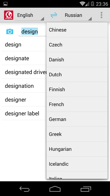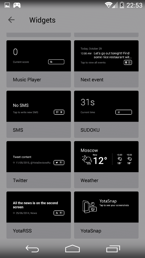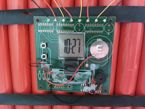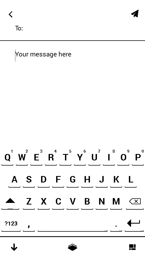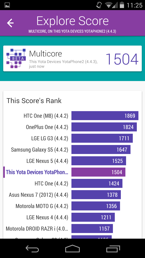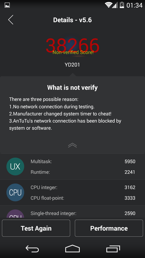YotaPhone 2 is definitely an original, prestige and unusual device. At first it catches our attention with the package, but then it gets even more interesting. Because how many smartphones have two fully sized touch displays? The Russian technology is impressive in this case, but the cost is definitely too high. The fact that Vladimir Putin himself is the ambassador of this model will not help.

YotaPhone 2 (YD201 model) is definitely a premium class product. We can feel it in the design and in the quality of the construction, perfect aesthetics, as well as accessories and packaging. We can feel it when we are holding it. We can see it in innovative solutions never seen before.
Contents
- Packaging and accessories. Housing and design. Displays.
- System and applications
- Multimedia. Camera
- Communication and connectivity. Memory and efficiency (benchmarks). Battery. Summary
Photo: Jolanta Szczepaniak/GSMchoice.com
Advantages:
- attractive looks
- efficiency
- AMOLED display
- second e-ink display
- Android in 4.4.3 version without manufacturer’s add-on
- few preinstalled, useless apps
- high quality of design
- power managing
- quality and loudness of sound
Disadvantages:
- price
- battery cannot be changed
- no memory card slot
- no trigger shutter
- no notification’s LED
- old components
- using two displays is not completely intuitive
- low resolution and no backlight for e-ink display
- responsiveness of e-ink display
Packaging and accessories
YotaPhone 2 makes an impression even before we take it out of the box. And this is no usual box. We have an elegant, black box with a magnetic flip, what is more the facture is nice in touch. Inside, after opening it, we can see the phone and neat “modules” with accessories. Each accessory is placed in a black sponge and is protected by a black piece of cardboard with the description of the content.
Accessories cover a 1.5-amper, module charger, a USB cable, a wire for removing the nanoSIM card and earphones with tons of replaceable plugs. There is a multilanguage manual as well. When it comes to the content this is rather a basic set, but when it comes to the packaging – it is one of a kind.
Photo: Jolanta Szczepaniak/GSMchoice.com
Housing and design
The front panel of YotaPhone 2 is occupied by a 5-inch display surrounded by wide bezels. The upper part has the phone’s speaker and the camera for video calls and sensors: light and proximity. The lower part does not have any elements (we have display keys) and its thickness is probably only to maintain the symmetry with the upper bezel.
On the top edge we have a universal earphone’s jack, on the lower part a microUSB socket surrounded by a speaker and a microphone. The left side lacks any additions, and on the right we can see power/lock button and volume controls buttons, which at the same time is a plate for mounting the SIM card in the nano size.
Photo: Jolanta Szczepaniak/GSMchoice.com
Much more interesting things happen at the back. Here we have a camera with a LED flash, in the lower part we have the phone’s name and in the centre there is a 4.7-inch display based on an e-paper.
Photo: Jolanta Szczepaniak/GSMchoice.com
The phone is perfectly designed and manufactured. It has nicely rounded corners and lies in the hand comfortably. A nice in touch plastic is used on edges, and both displays are protected by Gorilla Glass 3. The thickness of the phone is impressive, it is only 9 mm.
Displays
Two displays are the main and the most important elements of YotaPhone 2. Because of this innovation the manufacturer priced this model really high, and it stands out from other smartphones because of this. I cannot deny – this solution has sense, and the e-ink display can be used in an interesting way.
Photo: Jolanta Szczepaniak/GSMchoice.com
AMOLED display
The main display of the smartphone is a colourful 5-inch AMOLED display with a Full HD resolution, that is 1920x1080 pixels. It gives a pixel density on the level of 441 ppi, which gives a really high quality of the image. The display is characterized by a high brightness, a really good contrast, great colours and perfect viewability angles. AMOLED offers a deep level of black and saturated colours. The touch panel works without any problems. The display is protected by Gorilla Glass 3. There is simply nothing to complain about.
E-ink display
The second display is a 4.7-inch display made in the e-ink technology. It has a resolution of 960x540 pixels. (we cannot deny that pixels are visible with our own eyes) and it offers 16 levels of grey. The display is protected by Gorilla Glass 3 in a matte version. The manufacturer claims that the speed of refreshing is on the level of 0.012 seconds but we will often come across the ghosting effect nevertheless.
Photo: Jolanta Szczepaniak/GSMchoice.com
The touch panel of the e-ink display has a low sensitivity and all gestures must be done slowly and precisely. A severe limitation of the display is no backlight. But there are advantages of the e-paper as well – it is power saving and it does not tire eyes while reading. In a bright light it offers a better contrast and readability – that is in conditions during which we cannot see anything on other types of displays.
Photo: Jolanta Szczepaniak/GSMchoice.com
Interface and applications
A pure Android (4.4.3) is definitely an advantage, just like the small quantity of preinstalled apps. We have a soft designed to work with the e-ink display and a typical set of applications from Google.
Photo: Jolanta Szczepaniak/GSMchoice.com
We can pay attention to multilanguage ABBYY Lingvo dictionaries or the LitRes application (a built-in LitRes bookshop with Russian books). For viewing and editing documents we have a preinstalled OfficeSuite 8.
Photo: Jolanta Szczepaniak/GSMchoice.com
The e-paper part can take the role of the main display and show the Android interface (YotaMirror). Everything works slower and is displayed in shades of grey, but we can do everything that can be done on the colourful display: play games, watch movies, view photos in the gallery, take photos, use the navigation etc. Though in shades of grey and with a slow refreshing of the display it will not be comfortable.
Using the additional display by dedicated apps and widgets looks completely different. YotaHub allows to choose and to configure what will be visible on the e-paper display. We can choose two modes: YotaCover (something like a lock screen) and YotaPanel (main desktops).
In the YotaCover mode the display can have a wallpaper chosen by the user, on which notification’s icons are placed. We can use photos from the phone’s memory or from the Internet (galleries from Facebook or Instagram) that change from time to time.
Photo: Jolanta Szczepaniak/GSMchoice.com
The second mode of the e-paper display is YotaPanel - a set of desktops with widgets. The user has the possibility to configure individual desktops on which he or she can choose the looks of the grind on which there will be placed widgets and apps’ icons or one of default desktops on which there are placed weather information, current hour, day schedule, battery level, notifications icons etc.
Photo: Jolanta Szczepaniak/GSMchoice.com
For viewing the content on the e-ink display we can use the e-book reader YotaReader, which can work both on the colour as well as the black and white display. It allows to change the size of the text and viewing it on a white or a black background. The second app of this kind is YotaRSS. It allows to check the latest news from selected channels, but first we will need to log in to Feedly.
Photo: Jolanta Szczepaniak/GSMchoice.com
Games are assigned for the e-paper display as well. We can run them from the colourful AMOLED display, but the game will be moved to the black and white display. We have preinstalled four titles: Chess, Draughts, Sudoku and 2048.
Photo: Jolanta Szczepaniak/GSMchoice.com
Multimedia
In YotaPhone 2 the multimedia capabilities are not the most important, still the smartphone works really well while playing music, watching movies or editing photos. The speaker does not have an optimal localization (the lower edge of the phone), but when it comes to the quality and loudness it works decently. Audio files will be played by Google’s Music app; there is an FM radio (recording auditions to 3GPP format) and a recorder (also to the 3GPP format) as well.
Photo: Jolanta Szczepaniak/GSMchoice.com
The Gallery is responsible for viewing photos and editing them. It allows to sort photos by albums, localization or time, share them. It allows to edit them in a simple way, like adding colourful effects or frames. The Gallery is responsible for playing movies as well.
Camera
YotaPhone 2 offers an 8-megapixel main camera – I expected a more impressive matrix, especially that flagships from the competition have cameras with 16-megapixel (Galaxy S5), or even 20.7-megapixel (Xperia Z3). But the quantity of pixels does not always reflects the quality of photos – in the Russian product it is satisfactory. But the thing is that similar results can be achieved with a smartphone for less than 240 euros – in a smartphone that costs almost three times as much as this the camera should be much better. Biggest disadvantages of YotaPhone 2 are setting the white balance and problems with focus in close-ups.
Photo: Jolanta Szczepaniak/GSMchoice.com
When it comes to settings the camera looks rather modest – the system app offers spherical photos, panoramic ones, photos with the effect of lens blur, a typical auto-mode with the HDR mode and a timer and a camera for recording videos. We will not find any colours effect nor more advanced manual settings.
Sample photos using the Blur effect:
Photo: Jolanta Szczepaniak/GSMchoice.com
Sample panoramic photos:
Photo: Jolanta Szczepaniak/GSMchoice.com
And sample auto-mode photos:
Photo: Jolanta Szczepaniak/GSMchoice.com
The main camera allows to record videos in 1080p resolution. At the front we have a 2-megapixel camera for videocalls (but not by the mobile network) and for selfies. For them, however, we can use the better 8-megapixel camera, viewing the image on the e-paper display.
Connectivity and communication
The smartphone is equipped with a fast LTE modem, it has a modern dual band 802.11 b/g/n/ac Wi-Fi with a hotspot, a Bluetooth and an NFC technology. GPS with aGPS and GLONASS usage is responsible for localization services. All these modules work without any problems.
Photo: Jolanta Szczepaniak/GSMchoice.com
Android apps for calls and texts are doubled by widgets with an analogic functionality on e-paper YotaPanels. That is why we can receive and send texts and make calls (for having a conversation, however, we will need to turn the phone around). The quality of calls is really good – unfortunately there is no possibility to record calls and to have a video call through a mobile network.
Photo: Jolanta Szczepaniak/GSMchoice.com
Memory and efficiency
The smartphone has a built-in memory with a 32GB capacity out of which around 25GB are available for user. Unfortunately there is no memory card slot.
The heart of the smartphone is a quad-core 2.2GHz Qualcomm Snapdragon 800 CPU. This is an efficient component, though a bit older and weaker than those used in models such as LG G3 or Sony Xperia Z3. What is more both models offer 3GB of RAM, while YotaPhone 2 has only 2GB – and they are cheaper than the Russian dual-screen…
Still the efficiency is on a high level, we will not have slightest delays or lags, and even more demanding games will work smoothly even in the most demanding moments. Results of benchmarks look as follows:
Photo: Jolanta Szczepaniak/GSMchoice.com
Battery
YotaPhone 2 has a cell of a 2500 mAh capacity – according to the manufacturer it should last not for few hours, but for a few days (after configuring the YotaEnergy app). The estimated time of work should be over 100 hours, and the time of using the Internet in the 4G network – over 24 hours.
When we are using only the colourful display, the smartphone works similar to other smartphones, that is around 1-1.5 day. Or few hours while gaming or watching movies. The main display used alternatively with the e-paper gives around 2.5 days of work. Because of the limited time of reviewing I did not manage to check the lifespan when using only the e-ink display.
Photo: Jolanta Szczepaniak/GSMchoice.com
Charging the phone with the added charger takes around 2 hours. What is more after connecting the smartphone the YotaPhone logo on the charger is highlighted with a white colour – but only when YotaPhone 2 is connected.
Summary
YotaPhone 2 is one of the more eccentric gadgets that I have dealt with. This is definitely an innovative device, which brings a refreshing breeze to the market of almost identical smartphones working under Android. Maybe thanks to this YotaPhone 2 will find enthusiast among gadget-lovers. Especially those with a fat wallet. The device costs 690 euros! This is definitely too much…
Source: GSMchoice.com
- Show all |
- 1
- 2
- 3
- 4
- 5











































